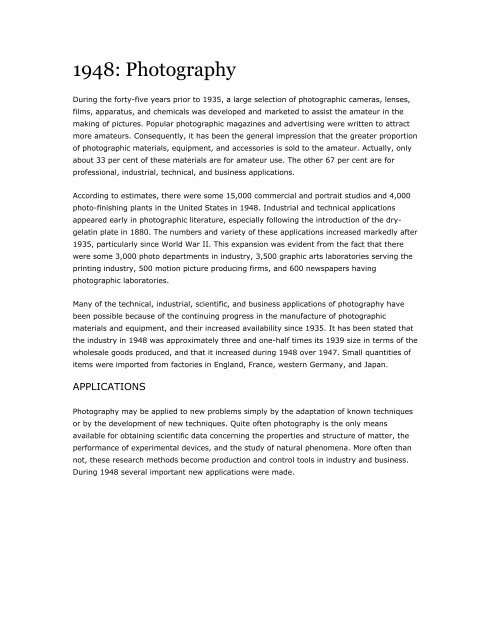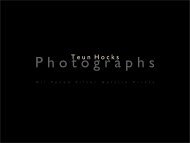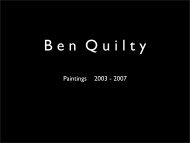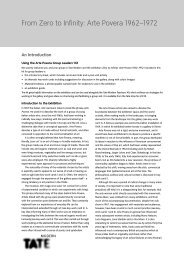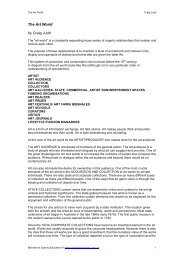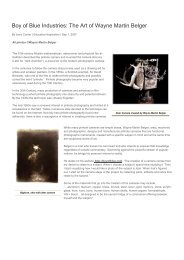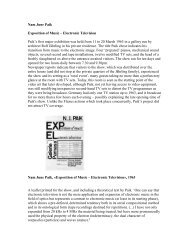1948: Photography - R . E . W . I . R . E . D
1948: Photography - R . E . W . I . R . E . D
1948: Photography - R . E . W . I . R . E . D
You also want an ePaper? Increase the reach of your titles
YUMPU automatically turns print PDFs into web optimized ePapers that Google loves.
<strong>1948</strong>: <strong>Photography</strong><br />
During the forty-five years prior to 1935, a large selection of photographic cameras, lenses,<br />
films, apparatus, and chemicals was developed and marketed to assist the amateur in the<br />
making of pictures. Popular photographic magazines and advertising were written to attract<br />
more amateurs. Consequently, it has been the general impression that the greater proportion<br />
of photographic materials, equipment, and accessories is sold to the amateur. Actually, only<br />
about 33 per cent of these materials are for amateur use. The other 67 per cent are for<br />
professional, industrial, technical, and business applications.<br />
According to estimates, there were some 15,000 commercial and portrait studios and 4,000<br />
photo-finishing plants in the United States in <strong>1948</strong>. Industrial and technical applications<br />
appeared early in photographic literature, especially following the introduction of the drygelatin<br />
plate in 1880. The numbers and variety of these applications increased markedly after<br />
1935, particularly since World War II. This expansion was evident from the fact that there<br />
were some 3,000 photo departments in industry, 3,500 graphic arts laboratories serving the<br />
printing industry, 500 motion picture producing firms, and 600 newspapers having<br />
photographic laboratories.<br />
Many of the technical, industrial, scientific, and business applications of photography have<br />
been possible because of the continuing progress in the manufacture of photographic<br />
materials and equipment, and their increased availability since 1935. It has been stated that<br />
the industry in <strong>1948</strong> was approximately three and one-half times its 1939 size in terms of the<br />
wholesale goods produced, and that it increased during <strong>1948</strong> over 1947. Small quantities of<br />
items were imported from factories in England, France, western Germany, and Japan.<br />
APPLICATIONS<br />
<strong>Photography</strong> may be applied to new problems simply by the adaptation of known techniques<br />
or by the development of new techniques. Quite often photography is the only means<br />
available for obtaining scientific data concerning the properties and structure of matter, the<br />
performance of experimental devices, and the study of natural phenomena. More often than<br />
not, these research methods become production and control tools in industry and business.<br />
During <strong>1948</strong> several important new applications were made.
Scientific Applications.<br />
Atomic Physics.<br />
Special photographic plates have been available for studies in atomic physics, for the purpose<br />
of studying and identifying various nuclear particles separated from the atom by means of<br />
cyclotrons, betatrons, and synchrotrons. The particles are recorded as tracks in special<br />
emulsions of high silver halide content and low background fog. The tracks are characteristic<br />
for a given particle and are found by tedious examination of many small areas of the plate<br />
under a microscope. From the length and curvature of the track and the grain spacing, particle<br />
speed and other characteristics are determined. The electron — the lightest of all atomic<br />
particles — was first definitely identified in <strong>1948</strong> at the Kodak Research Laboratories in<br />
Harrow, England, and Rochester, New York, with new types of photographic plates. Tracks<br />
from 30 microns to 250 microns long were found. The latter were recorded on special<br />
ultrasensitive plates. The meson, which may have a life as short as one millionth of a second,<br />
can be recorded. Gardner and Lattes, at the Radiation Laboratory of the University of<br />
California, recorded on special plates mesons which were created artificially by bombarding<br />
various materials with helium nuclei in the giant cyclotron. Tracks of atomic fission of uranium<br />
and of thorium have also been recorded.<br />
Autoradiography.<br />
Special photographic emulsions, approximately 1/5,000 of an inch thick, were used in <strong>1948</strong> to<br />
locate the presence of radioactive substances in biological specimens and plants. Radioactive<br />
iodine and phosphorus, when injected into an animal, are selectively absorbed by the thyroid<br />
and bone respectively. Microsections of the tissue, when placed in contact with the emulsion,<br />
produce a heavy exposure in areas adjacent to the radioactive portions of the specimen. This<br />
technique was used in the study of cancer and other diseases.<br />
Gamma Ray Radiography.<br />
Scientists of the Ford Motor Company announced the possible application of radioactive<br />
isotopes in the production of automobiles in connection with material processing, radiography,<br />
liquid level indication in foundry cupolas, and thickness control in sheet-steel making. Cobalt<br />
60 and selenium 75 are gamma ray emitters. The former proved useful in checking welds in<br />
high-pressure steam lines, and is comparable to a 2 million-volt X-ray in penetrating power.<br />
The selenium 75 was more suitable for light metal sections.
Astronomy.<br />
Special photographic plates will be used on the 200-in. reflecting telescope on Palomar<br />
Mountain in California, which was dedicated May 3, <strong>1948</strong>. These plates will have<br />
approximately four times the speed of the plates originally designated for this equipment.<br />
Specially sensitized emulsions will be used in a spectroscope, to be attached to the telescope,<br />
to measure various characteristics of the stars. The California Institute of Technology released<br />
a color motion picture, The Story of Palomar.<br />
High-Speed <strong>Photography</strong>.<br />
High-speed photographic techniques were used in several hydrodynamic research problems.<br />
At the Naval Ordnance Test Station in Inyokern, Calif., spinning submerged bodies were<br />
photographed at 1/500,000-second exposure to study wake form. Also, the behavior of<br />
models of underwater missiles was studied with high-speed motion pictures. It was thought<br />
that this study might lead to the accurate prediction of design. The General Electric Company<br />
described a new water table which was used with models to simulate two-dimensional air flow<br />
at speeds up to 10,000 mi. per hour. The slow-speed surface waves in water act much the<br />
same way as high-speed airwaves. These studies were made in connection with supersonic<br />
flight research possibilities. Dr. Charles M. Slack, Director of Research for the Westinghouse<br />
Lamp Division, described the development of super-speed X-ray motion pictures before the<br />
American Physical Society. The movies were obtained without blur by using X-ray exposures of<br />
1/100,000 of a second and a shutterless camera shooting movies at 100 frames a second. The<br />
X-ray exposures repeated at 1/100-second intervals were recorded on a continuously moving<br />
strip of regular movie film. Movies made of the reaction between iron oxide and aluminum in a<br />
metal crucible lined with refractory material revealed the actual melting phenomenon inside<br />
the crucible and the subsequent bursting of molten metal through the steel plate. A regular<br />
movie showed only a shower of sparks and molten metal gushing out of the bottom of the<br />
crucible.<br />
The Zarem camera, named after Dr. A. M. Zarem, who designed it for the United States Navy,<br />
is an all-electric camera that has the fastest shutter yet devised and is capable of exposures<br />
made at 100 millionths of a second. The camera shutter is based on the well-known principle<br />
of the Kerr cell, which consists of a glass tube filled with nitrobenzene with two immersed<br />
electrodes. The cell is mounted between crossed polarizing filters. When a high voltage is<br />
applied to the electrodes of the Kerr cell, the fluid rotates the light so that it passes through<br />
the second polarizer to make an exposure. Normally, light passed through the first polarizer is<br />
blocked by the second filter. Applications of this camera for ultra high-speed photography<br />
were being investigated as <strong>1948</strong> came to an end.
Rocket <strong>Photography</strong>.<br />
In <strong>1948</strong> additional progress was made in the various aspects of rocket photography. Special<br />
cameras were installed in rockets and were operated automatically. The equipment was<br />
released automatically from the rocket and then lowered by parachute. Composite<br />
photographs made from these records showed a 2,700-mi. arc of horizon when the V-2 rocket<br />
was at a height of 60 mi. The mosaic of seven exposures made at 1�-sec. intervals showed an<br />
extent of country from Mazatlán, Mex., to Hyannis, Neb. Another sequence, taken from a navy<br />
Aerobee rocket at a height of 70 mi., showed an hourglass-shaped panorama 1,400 mi. long.<br />
Both rockets were fired from launching sites near White Sands, N. Mex.<br />
Under-Sea <strong>Photography</strong>.<br />
Dr. Maurice Ewing has used photography extensively in his studies of life and geology under<br />
the sea. In <strong>1948</strong>, he made successful flash shots as far down as 3� mi. below the ocean<br />
surface where sponge-like formations were recorded. The camera and flash apparatus were<br />
placed in water-tight containers and lowered to the ocean bottom where a trigger released the<br />
flash.<br />
Technical Applications.<br />
Ultrafax.<br />
During 1947 a communication system known as Ultrafax was disclosed. The system was<br />
demonstrated effectively on Oct. 21, <strong>1948</strong>, at the Library of Congress in Washington, D.C.,<br />
when the entire 1,047-page novel, Gone with the Wind, was transmitted a distance of three<br />
mi. in about two minutes. The original material is copied page by page on 35 mm. film which,<br />
after processing, is fed into the Ultrafax television system at 30 messages per second or 1,800<br />
pages a minute. The transmitted messages are recorded on 16 mm. movie film, which is<br />
processed rapidly at temperatures up to 130ø F. ready for immediate projection or multiplecopy<br />
prints. This system was developed by the Radio Corporation of America with the cooperation<br />
of the Eastman Kodak Company and the National Broadcasting Company. Its<br />
possible application to the transmission of messages, printed matter, charts, documents, and<br />
other material was being investigated at the close of <strong>1948</strong>.<br />
Aerial <strong>Photography</strong>.<br />
The tri-metrogon system of aerial photography was used in <strong>1948</strong> by the United States Navy in<br />
a survey of 30,000 sq. mi. of Alaskan territory in co-operation with the Department of the<br />
Interior and other government agencies. The same system was used on September 1 by the<br />
United States Air Force in a nonstop flight of 2,700 mi. from Santa Barbara, Calif., to New<br />
York City to test aerial cameras and photographic techniques under extended flight conditions.<br />
At 40,000 ft., each of three cameras made 390 exposures on one film at 50-sec. intervals with
a tri-metrogon installation using three K-17 type cameras fitted with 6-in. lenses. Three<br />
hundred twenty-six ft. of film were used from each of three 400-ft. rolls. This first continuous<br />
photographic record covered an area about 490 mi. wide by 2,700 mi., and showed clearly the<br />
location of cities and landmarks. The plane traveled at 375 mi. per hr. and made the flight in 6<br />
hrs. 55 min., including take-off and landing time.<br />
Aerial strip cameras, such as the S-7, have been used for reconnaissance flights at low<br />
altitudes, but, at the greatly increased speeds of airplanes, photographs without image motion<br />
have been difficult to obtain. An experiment was made to simulate a speed of 1,000 mi. per<br />
hour by the Photographic Laboratory, Engineering Division, Air Material Command, of the<br />
United States Air Force. Two P-80 jet planes were equipped with strip cameras with lenses of<br />
6-in. and 24-in. focal length; and, with the movement of the film past the slit, was<br />
synchronized to record a plane speed of 1,000 mi. per hour. The plane speed was obtained by<br />
having each jet plane travel at 500 mi. per hour in opposite directions with a separation of 500<br />
ft. A dimensional accuracy within 2 per cent in the direction of the flight was obtained in the<br />
pictures.<br />
<strong>Photography</strong> replaced the pilot in some flight tests. A P-80 jet drone plane was used, equipped<br />
with four motion picture cameras operated by remote control from either the ground or a<br />
mother plane. The cameras were located to record the instrument panel, each wing tip, and a<br />
television camera in the nose. A fifth camera photographed the television receiver screen in<br />
the ground control truck.<br />
A major problem in the study of plane take-offs and landings was solved by the Lockheed<br />
Aircraft Corporation. The planes were photographed with a motion picture camera through a<br />
special wire grid, 9 ft. high and 64 ft. long. Vertical wires marked off 100-ft. runway sections,<br />
and horizontal wires indicated increasing altitude.<br />
The United States Army Corps of Engineers employed an automatic focus rectifier in mosaicmap<br />
making, which was built by the Bausch & Lomb Optical Company. It was possible to<br />
enlarge, reduce, or correct for tilt when printing aerial negatives. It has possible application in<br />
mapping national highways and in soil erosion studies and flood control work.<br />
Radar <strong>Photography</strong>.<br />
During early spring the first radar navigation chart of over 300 mi. of the Ohio River was<br />
completed from a mosaic of photographs of the radar-scope images. The Mirar camera, with a<br />
capacity of 100 ft. of 35 mm. film, made by the Fairchild Camera and Instrument Corporation,<br />
was said to be suitable for use with ship-borne radar equipment.
Sports <strong>Photography</strong>.<br />
A special moving-film slit-camera was used in several of the running, hurdling, and walking<br />
events at the Olympic Games at Wembley, England. The moving film speed was adjusted to<br />
the estimated speed of the contestants at the finish line, and the prints were delivered to the<br />
judges within 60-90 sec. after the finish of the race. Rapid processing equipment was used.<br />
Industrial Applications.<br />
Photometric System.<br />
The announcement of the photometric system introduced photography into men's tailoring.<br />
The photometric camera was specially designed to be foolproof and to take automatically the<br />
pictures required. The customer was fitted with a tapemeasure harness and then placed in an<br />
exact location before nine mirrors. The final pictures were projected in half-scale onto a<br />
screen, and accurate measurements were obtained by means of calculating scales on the<br />
screen and a geometric calculator.<br />
Area Integrator.<br />
The estimation of the volume of pulpwood in stock piles, in flat cars, and elsewhere is an<br />
important operation in the pulpwood industry. The success of a photographic method was<br />
dependent upon a photoelectric area integrator, which determined the volume directly from<br />
the photographic negative. It was indicated that the area integrator had possible applications<br />
in other fields.<br />
Autopositive Paper.<br />
In October 1947 the Eastman Kodak Company announced Kodagraph autopositive paper. An<br />
important application of this material has been its use as an intermediate in the field of<br />
engineering drawing reproduction. The adaptation of blueprint processing equipment to the<br />
continuous processing of autopositive paper for large volume production was described during<br />
<strong>1948</strong>.<br />
Motion Pictures and Television.<br />
It was apparently recognized in <strong>1948</strong> that motion pictures would be required for some years to<br />
come to augment live-talent shows in television. This was evidenced by the fact that film<br />
producers, such as Jerry Fairbanks, signed contracts to make several hundred feature<br />
television films yearly. Several subjects of the "Public Prosecutor" series were completed for<br />
television.
Theatre Television.<br />
Theatre television was demonstrated using a film-recording system at the Paramount Theatre<br />
in New York City. On April 14 a boxing bout at the Navy Y.M.C.A. in Brooklyn was televised to<br />
the theatre where the image on a 15-in. cathode-ray tube was photographed on 35 mm. film<br />
and processed ready for projection within 66 sec. This processing time was subsequently<br />
reduced to 22 sec. An alternative method, involving direct instantaneous projection of the<br />
televised image, was demonstrated on an 18-ft. screen in the Shrine Auditorium in Los<br />
Angeles on January 1. It was said that probably both methods would be used in the theatre,<br />
but certain advantages were claimed for the film-recording method.<br />
Amateur Motion Pictures.<br />
Statistics were published showing the growth of interest in amateur motion pictures. These<br />
were of considerable interest since <strong>1948</strong> was the twenty-fifth anniversary of the 16 mm.<br />
reversal process. Approximately 825,000 families owned 8 mm. cameras; 275,000 families<br />
owned 16 mm. cameras and 950,000 families owned projectors. There was an increased<br />
interest in the use of magnetic-tape sound-recording among owners of 8 mm. equipment.<br />
Improved techniques, cameras, and films were believed responsible for improved quality and<br />
an extended use of 16 mm. movies in the instructional, industrial, medical, and scientific<br />
fields. It was predicted by the United States Office of Education that more than 8,000 different<br />
industrial and educational films would be available by 1950.<br />
Color <strong>Photography</strong>.<br />
The demand for both amateur and professional color films exceeded available supplies despite<br />
the fact that manufacturers had increased production. It was stated by one analyst that more<br />
than 25 per cent of the 35 mm. still photography in the United States and 85 per cent of the<br />
amateur movie market was in color. Between 50 and 100 concerns were engaged in<br />
processing exposed color film.<br />
Films.<br />
Improvements were noted in the quality of several older color materials such as Ansco color<br />
films and Printon, Ektachrome, and Kodachrome films. Some of this improvement was due to<br />
improved techniques used by professional photographers, especially in regard to the<br />
retouching of transparencies and prints, lighting control, and multiple exposures. Kodachrome<br />
and Kodacolor prints were made available in larger sizes up to 11 by 14 in.
Developers.<br />
New chemicals and processing formulas and techniques were described in the literature.<br />
Coppin and Spencer reported the details of the Vivex process, July-August <strong>1948</strong>. It was<br />
thought that this information would be of help to photographers using the Carbro process,<br />
since the basic principles were believed to be an improvement over the Carbro process. May<br />
and Baker Limited in England announced a reducing agent known as "Genochrome" for use in<br />
color developers. Both Kodak and Ansco featured nontoxic color developers.<br />
Color Reproductions.<br />
More effort was apparently directed towards improving the quality of color reproductions in<br />
magazines and books. Some printing shops accepted the new techniques of masking color<br />
transparencies and employed better quality paper for the reproductions. Life magazine<br />
published some very excellent reproductions in color including the following: a full-page spot<br />
news picture of a big fire in Montreal; the first published color photograph of the planet Mars;<br />
and a series of color photomicrographs of sludge in blood cells made by F. W. Goro. The New<br />
York Times, on September 12, reproduced by color rotogravure thirteen color pictures of the<br />
national political conventions in Philadelphia.<br />
Color Motion Pictures.<br />
In the field of color motion pictures, the program expansion of the Technicolor Motion Picture<br />
Corporation was noteworthy. More than a 50-percent increased capacity was accomplished by<br />
midyear <strong>1948</strong> in a program which called for an increase from 160 million ft. per year printmanufacturing<br />
volume to a goal of 320 million ft. by the end of <strong>1948</strong>. Cinecolor predicted an<br />
increased capacity. They expected to have completed 45 feature pictures at the end of <strong>1948</strong>.<br />
In the Trucolor process of Republic Pictures color couplers are used to form a red dye image<br />
on one side and a blue dye image on the other side of the film.<br />
New Color Processes.<br />
Some new color motion picture processes were announced. The Polaroid Corporation<br />
announced the Polacolor process, which was said to produce three separate color images in a<br />
single layer from three color-separation negatives. Standard processing and projection<br />
apparatus were used. Gevaert announced "Gevacolor," said to be a version of the German<br />
Agfacolor process. The color couplers are contained in the emulsion layers of an integral<br />
tripack, and orthodox reversal color processing was employed. Rouxcolor, an additive system<br />
of color photography, was described. It employs a lens system forming four images in the<br />
areas usually filled by one image on a standard negative. Deep red, yellow, green, and violet<br />
color filters over each lens component are used in both the camera and projector. The four<br />
images are superimposed on projection.
MATERIALS AND EQUIPMENT<br />
Materials.<br />
Each year, particularly since World War II, a considerable number of new sensitized materials,<br />
chemicals, cameras, and processing equipment have been announced. The new products<br />
introduced during <strong>1948</strong> are summarized below:<br />
Sensitized Materials.<br />
Probably the most important announcement in the field of film manufacture was made by C.<br />
R. Fordyce, who described an improved safety motion picture film support. The product was<br />
said to be a highly acetylated cellulose acetate having improved physical properties and better<br />
aging characteristics than commercial safety film in professional use. It was predicted that the<br />
new safety film would probably replace nitrate film support within a few years.<br />
A few of the new sensitized products announced during the year are the following: improved<br />
Anscocolor Printon, Ansco strip paper No. 55 in 1,000-ft. rolls, Ansco Cykora paper, Remington<br />
Rand Rembrandt Chlorobromide projection and contact paper, Rapid F Velox unicontrast paper<br />
in sheets and in 1,000-ft. rolls for strip printing, Kodagraph contact duplitized paper, Kodak<br />
separation negative plates Type I, Kodak highlight masking film, Kodak super-X and super-XX<br />
blue base reversal films, and Weimet reversal safety color film. Special photographic plates for<br />
the 48-in. Schmidt-type telescope on Mount Palomar were supplied on very thin (0.040 in.)<br />
glass which could be bent into a section of a sphere.<br />
The Armstrong Cork Company, with the co-operation of the National Association of<br />
Photographic Manufacturers, prepared an especially interesting advertisement on "How<br />
Photographic Film Is Made." This appeared in the Saturday Evening Post, January 17, and<br />
reproduced in color a cutaway drawing of the various stages of film manufacture as<br />
symbolically conceived in one large building. Also the Foto-Fab and Phototone methods of<br />
sensitizing fabrics were announced.<br />
Chemicals.<br />
Packaged chemicals, in bottles or packets, were generally employed in <strong>1948</strong>, and in some<br />
instances increased use of these was indicated. One firm supplied processing chemicals in<br />
small heat-sealed metal foil units for amateur workers.<br />
A one-bath reversal process was described by H. A. Miller in the Journal of the Photographic<br />
Society of America (February <strong>1948</strong>). The method permitted positive transparencies to be<br />
made on film after camera exposure or print duplicates of negatives or positives without the<br />
usual intermediate step.
Apparatus or Equipment.<br />
Land Camera.<br />
In 1947, Dr. E. Land of the Polaroid Corporation announced the basic principle for a one-step<br />
photographic-process camera. A commercial model of such a camera was demonstrated at the<br />
Photographic Society of America convention in Cincinnati, Ohio. With the Land process a<br />
finished print can be made in the camera within one minute after the exposure.<br />
Beattie Camera.<br />
The Beattie Portronic camera, recommended for studio portraiture and industrial identification,<br />
was introduced. Exposure with electronic synchro-flash, imprinting of an identification number,<br />
and advancement of the film are accomplished automatically by push-button control. The<br />
camera holds 100 ft. of 70 mm. film.<br />
New Small Cameras.<br />
Several still cameras were added to the small-camera market, including three Ansco models,<br />
the Flash Clipper, the standard Speedex, and the Titan; four new Kodak Tourists; the Kodak<br />
Duaflex, the Perfex, series 100 camera; the Busch 4 by 5 Pressman; the Kalart camera; and<br />
the Bell and Howell Foton camera. The Foton is equipped with a spring-wound motor filmadvancing<br />
mechanism, a new type focal-plane shutter having two metal leaves behind the lens<br />
and two at the film plane, and a Cooke lens marked in the proposed T-stops which had not yet<br />
been accepted by the American Standards Association at the close of <strong>1948</strong>. The T-stop is<br />
determined by measuring the light of known spectral quality (noon sunlight) transmitted<br />
through the lens to the image plane. The camera makes double frame pictures on 35 mm.<br />
film, and 12 exposures within a second are claimed. The Kalart camera is said to be equipped<br />
with safety locks to prevent blank exposures and premature flashing.<br />
Foreign Importations.<br />
The following still cameras were imported: the British Coronet-Cameo; the German Linhof<br />
Technika, model III; and the Retina I and II made at the Kodak factory at Stuttgart, Germany.<br />
Motion Picture Accessories.<br />
A considerable number of accessories for 16 mm. cameras and projectors were announced<br />
during the year. A few new cameras were marketed. The Cine-Kodak Special Model II had<br />
several improvements, including a lens turret. Seven new Cine Ektar lenses were introduced<br />
which varied in focal lengths from 15 mm. (f/2.5) to 152 m. (f/4). The fastest lens of this<br />
group, the f/1.4 Ektar, was described by C. D. Reid in an article published in the Journal of the<br />
Photographic Society of America (August <strong>1948</strong>). The Revere 16 mm. sound projector model 48
was announced in October. Another accessory was the Craig 8 mm. Projector-Editor with<br />
viewing screen. The Cine Raptar f/1.5 was announced by the Wollensak Optical Company.<br />
Continuous Processing.<br />
The need for continuous processing in the photo-finishing business has been increasingly<br />
evident. During <strong>1948</strong> several attempts were made to introduce this type of equipment. The<br />
Eastman Kodak Company announced its continuous-paper processor machine designed to turn<br />
out 2,400 average size enlarged prints per hour. In addition, new roll-paper printing heads for<br />
use on two models of semi-automatic printers were also announced.<br />
Miscellaneous.<br />
The following items of miscellaneous equipment were also introduced during the year: Argus<br />
PA200 projector for 35 mm. slides; Kodaslide table viewer, holding 75 slides, which can be<br />
projected rapidly on a 7� x 7�-in. self-contained screen in full room light; Federal Store-Away<br />
Senior enlarger; Kodak Studio Speedlamp; and Kodak Color Densitometer.<br />
Summary.<br />
It was obvious that many advances and improvements were made during the year <strong>1948</strong> in<br />
photographic materials and equipment. Of special interest, of course, were the many new<br />
applications of photography, particularly in science and industry.<br />
Microsoft ® Encarta ® Reference Library 2003. © 1993-2002 Microsoft Corporation. All<br />
rights reserved.


